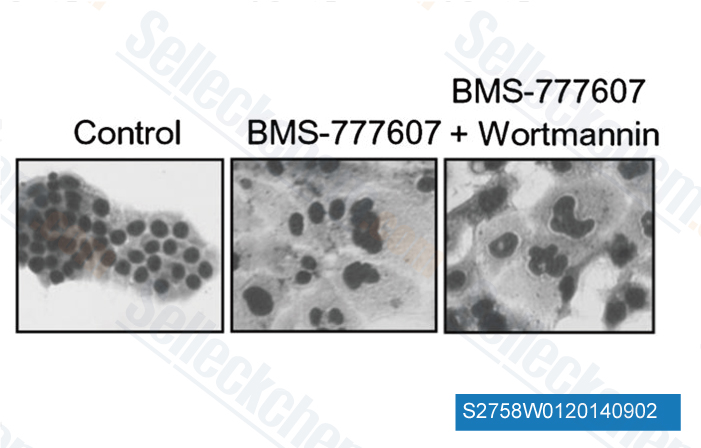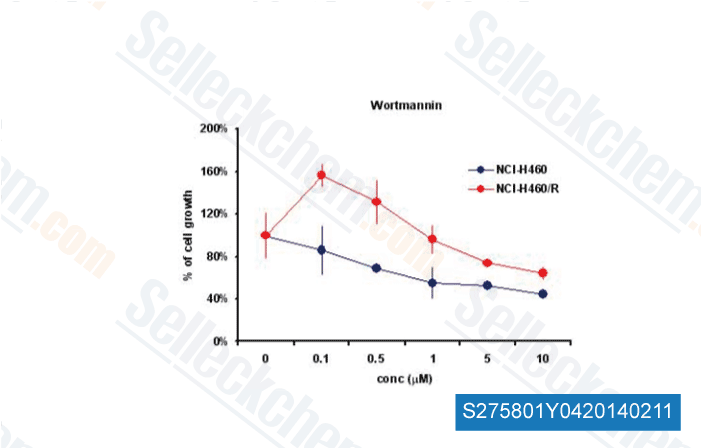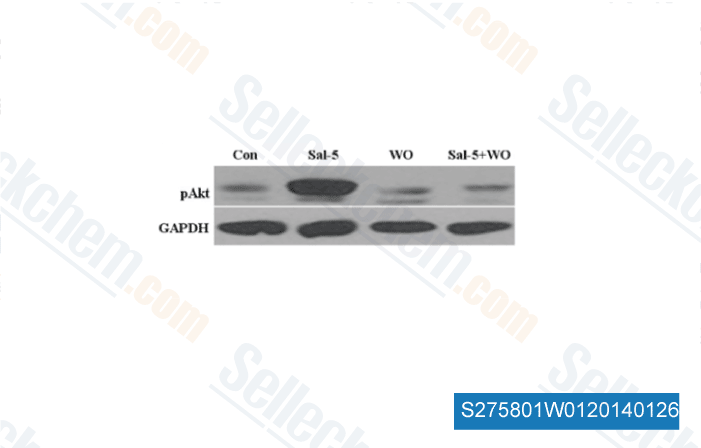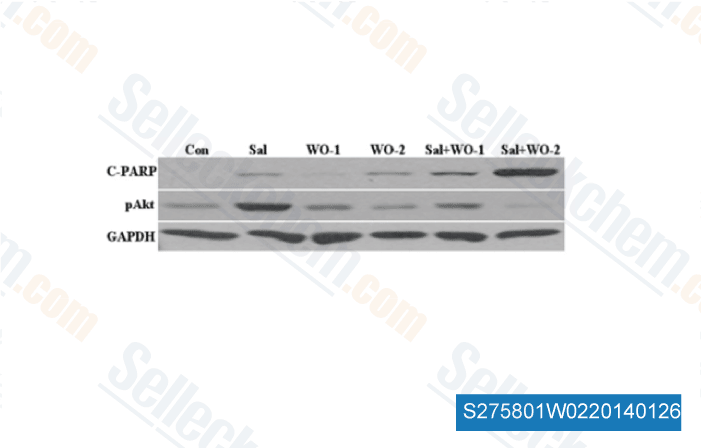|
Toll Free: (877) 796-6397 -- USA and Canada only -- |
Fax: +1-832-582-8590 Orders: +1-832-582-8158 |
Tech Support: +1-832-582-8158 Ext:3 Please provide your Order Number in the email. |
Technical Data
| Formula | C23H24O8 |
|||
| Molecular Weight | 428.43 | CAS No. | 19545-26-7 | |
| Solubility (25°C)* | In vitro | DMSO | 86 mg/mL (200.73 mM) | |
| Water | Insoluble | |||
| Ethanol | Insoluble | |||
|
* <1 mg/ml means slightly soluble or insoluble. * Please note that Selleck tests the solubility of all compounds in-house, and the actual solubility may differ slightly from published values. This is normal and is due to slight batch-to-batch variations. * Room temperature shipping (Stability testing shows this product can be shipped without any cooling measures.) |
||||
Preparing Stock Solutions
Biological Activity
| Description | Wortmannin is the first described PI3K inhibitor with IC50 of 3 nM in a cell-free assay, with little selectivity within the PI3K family. Wortmannin blocks autophagosome formation and potently inhibits DNA-PK/ATM with IC50 of 16 nM and 150 nM in cell-free assays. Wortmannin also inhibits PLK1 activity. | ||||||||
|---|---|---|---|---|---|---|---|---|---|
| Targets |
|
||||||||
| In vitro | The inhibition of MLCK by Wortmannin is not affected by calmodulin or peptide substrat, while reduced by high concentration of ATP. Wortmannin directly interacts with the catalytic domain of MLCK and leads to an irreversible loss of the enzyme activity. Wortmannin has no inhibitory to cAMP-dependent protein kinase, cGMP-dependent protein kinase, and calmodulin-dependent protein kinase II, and has little effect on protein kinase C activity. [1] Wortmannin inhibits N-formylmethionyl-leucylphenylalanine (fMLP)-stimulated PtdInsP3 (phosphatidylinositol 3,4,5-trisphosphate) formation with IC50 of 5 nM and this inhibition is completely abolished when pretreated with 100 nM Wortmannin in human neutrophils, with increased PtdInsP2 levels and no effects on cellular PtdInsP and PtdIns contents. Wortmannin could develop oscillatory changes in F-actin content and does not inhibit fMLP-stimulated actin polymerization in neutrophils. [2] Wortmannin irreversibly inhibits phosphatidylinositol 3-kinase (PI3-kinase) activity with binding to the 110-kDa protein (IC50 of 3 nM) and has no effect PI4-kinase in RBL-2H3 cells. Wortmannin also inhibits leukotriene release, with no effect on the activation of the tyrosine kinase Lyn. [3] Wortmannin completely abolishes the induced hexose uptake in isolated rat adipocytes at 0.1 μM, without impairing stimulated lipolytic activity. [4] Wortmannin suppresses induced production of nitric oxide by 50% at 500 nM in human umbilical vein endothelial cells, which is in response to IGF-1. [5] Wortmannin suppresses DNA double strand break (DSB) repair and has no effect on DSB levels or the kinetics of single strand break (SSB) repair in Chinese hamster ovary cells at 50 μM. Wortmannin could potentiate ionizing radiation (IR)-induced cytotoxicity with no toxicity by itself. [6] Wortmannin inhibits polo-like kinase (PLK1) activity IC50 of 24 nM in intact G2/M-arrested cells. [7] Wortmannin increases Toll-like receptor (TLR)-mediated accumulation of IL-6 in human macrophages with EC50 of 50 nM. Meanwhile Wortmannin significantly enhances TLR-mediated inducible nitric-oxide synthase (iNOS) expression and nitrite accumulation in mouse macrphages. Wortmannin activates the nuclear factor-κB and up-regulates the cytokine mRNA production. [8] Wortmannin also inhibits Polo-like kinase (PlK) 1 and PlK3, which play important roles in mitosis. Wortmannin treatment could lead to a reduction in phosphorylation of p53 on serine 20 induced by DNA damage. [9] Wortmannin suppresses hyaluronan-induced Akt phosphorylation and cell motility/migration in SW1990 cells. [10] |
||||||||
| In vivo | Wortmannin inhibits peritoneal metastasis of SW1990 in mice at 1 mg/kg, without any weight loss. [10] Wortmannin inhibits phosphatidylinositide 3-kinase-protein kinase B (PKB)/Akt phosphorylation in both normal tissues (lung, heart and brain homogenates) and tumor tissue in mice, without mortality or acute toxicity at 0.7 mg/kg. Combination with LY188011, Wortmannin significantly increases apoptosis and inhibit tumor growth in orthotopic tumor, while both monotherapy could not. [11] |
Protocol (from reference)
| Kinase Assay: |
|
|---|---|
| Cell Assay: |
|
| Animal Study: |
|
References
Customer Product Validation

-
Data from [Mol Cancer Ther, 2014, 13(1), 37-48]

-
, 2014, Dr.Milica Pesic from Institute for Biological Research

-
Data from [Int J Mol Sci, 2013, 14(9), 17304-18]

-
Data from [Int J Mol Sci, 2013, 14(9), 17304-18]
Selleck's Wortmannin has been cited by 350 publications
| USP5 stabilizes YTHDF1 to control cancer immune surveillance through mTORC1-mediated phosphorylation [ Nat Commun, 2025, 16(1):1313] | PubMed: 39900921 |
| Selective tubulin-binding drugs induce pericyte phenotype switching and anti-cancer immunity [ EMBO Mol Med, 2025, 10.1038/s44321-025-00222-6] | PubMed: 40140727 |
| Vegfr3 activation of Pkd2l1+ CSF-cNs triggers the neural stem cell response in spinal cord injury [ Cell Signal, 2025, 130:111675] | PubMed: 39986360 |
| RhFGF21 protected PC12 cells against mitochondrial apoptosis triggered by H2O2 via the AKT-mediated ROS signaling pathway [ Exp Cell Res, 2025, 445(1):114417] | PubMed: 39793749 |
| Effects of alpelisib treatment on murine Pten-deficient lipomas [ Adipocyte, 2025, 14(1):2468275] | PubMed: 39962643 |
| Biomolecular condensates mediate bending and scission of endosome membranes [ Nature, 2024, 10.1038/s41586-024-07990-0] | PubMed: 39385023 |
| Prostaglandin E2 controls the metabolic adaptation of T cells to the intestinal microenvironment [ Nat Commun, 2024, 15(1):451] | PubMed: 38200005 |
| Dynamin-dependent entry of Chlamydia trachomatis is sequentially regulated by the effectors TarP and TmeA [ Nat Commun, 2024, 15(1):4926] | PubMed: 38858371 |
| EBV-associated epithelial cancers cells promote vasculogenic mimicry formation via a secretory cross-talk with the immune microenvironment [ Theranostics, 2024, 14(13):5123-5140] | PubMed: 39267775 |
| RIG-I is an intracellular checkpoint that limits CD8+ T-cell antitumour immunity [ EMBO Mol Med, 2024, 10.1038/s44321-024-00136-9] | PubMed: 39322862 |
RETURN POLICY
Selleck Chemical’s Unconditional Return Policy ensures a smooth online shopping experience for our customers. If you are in any way unsatisfied with your purchase, you may return any item(s) within 7 days of receiving it. In the event of product quality issues, either protocol related or product related problems, you may return any item(s) within 365 days from the original purchase date. Please follow the instructions below when returning products.
SHIPPING AND STORAGE
Selleck products are transported at room temperature. If you receive the product at room temperature, please rest assured, the Selleck Quality Inspection Department has conducted experiments to verify that the normal temperature placement of one month will not affect the biological activity of powder products. After collecting, please store the product according to the requirements described in the datasheet. Most Selleck products are stable under the recommended conditions.
NOT FOR HUMAN, VETERINARY DIAGNOSTIC OR THERAPEUTIC USE.
